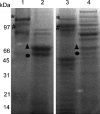Treponema denticola alters cell vitality and induces HO-1 and Hsp70 expression in porcine aortic endothelial cells
- PMID: 20091146
- PMCID: PMC3006620
- DOI: 10.1007/s12192-009-0164-3
Treponema denticola alters cell vitality and induces HO-1 and Hsp70 expression in porcine aortic endothelial cells
Abstract
Treponema denticola is an oral spirochete that is associated with periodontal disease and detected occasionally in extraoral lesions associated with systemic disorders such as cardiovascular diseases. The effect of specific bacterial products from oral treponemes on endothelium is poorly investigated. This study analyzed the ability of components of the outer membrane of T. denticola (OMT) to induce apoptosis and heat shock proteins (HO-1 and Hsp70) in porcine aortic endothelial cells (pAECs), compared with results obtained with classical pro-inflammatory lipopolysaccharide (LPS) treatment. Cellular apoptosis was detected when pAECs were treated with either OMT or LPS, suggesting that OMT can damage endothelium integrity by reducing endothelial cell vitality. Stimulation with OMT, similarly to LPS response, increased HO-1 and Hsp-70 protein expression in a time-dependent manner, correlating with a rise in HO-1 and Hsp-70 mRNA. Collectively, these results support the hypothesis that T. denticola alters endothelial cell function. Moreover, our in vitro experiments represent a preliminary investigation to further in vivo study using a pig model to elucidate how T. denticola leaves the initial endodontic site and participates in the development of several systemic diseases.
Figures






Similar articles
-
Water/ethanol extract of Cucumis sativus L. fruit attenuates lipopolysaccharide-induced inflammatory response in endothelial cells.BMC Complement Altern Med. 2018 Jun 25;18(1):194. doi: 10.1186/s12906-018-2254-1. BMC Complement Altern Med. 2018. PMID: 29941006 Free PMC article.
-
Heat shock protein 70, heat shock protein 32, and vascular endothelial growth factor production and their effects on lipopolysaccharide-induced apoptosis in porcine aortic endothelial cells.Cell Stress Chaperones. 2005 Winter;10(4):340-8. doi: 10.1379/csc-98r1.1. Cell Stress Chaperones. 2005. PMID: 16333987 Free PMC article.
-
Mesenchymal Stem Cells Modified with Heme Oxygenase-1 Have Enhanced Paracrine Function and Attenuate Lipopolysaccharide-Induced Inflammatory and Oxidative Damage in Pulmonary Microvascular Endothelial Cells.Cell Physiol Biochem. 2018;49(1):101-122. doi: 10.1159/000492847. Epub 2018 Aug 28. Cell Physiol Biochem. 2018. PMID: 30153667
-
Ramelteon protects against human pulmonary microvascular endothelial cell injury induced by lipopolysaccharide (LPS) via activating nuclear factor erythroid 2-related factor 2 (Nrf2)/heme oxygenase-1 (HO-1) pathway.Bioengineered. 2022 Jan;13(1):1518-1529. doi: 10.1080/21655979.2021.2021065. Bioengineered. 2022. PMID: 34986734 Free PMC article.
-
Heat shock proteins in the brain: role of Hsp70, Hsp 27, and HO-1 (Hsp32) and their therapeutic potential.Transl Stroke Res. 2013 Dec;4(6):685-92. doi: 10.1007/s12975-013-0271-4. Epub 2013 Aug 3. Transl Stroke Res. 2013. PMID: 24323422 Free PMC article. Review.
Cited by
-
The central region of the msp gene of Treponema denticola has sequence heterogeneity among clinical samples, obtained from patients with periodontitis.BMC Infect Dis. 2010 Dec 7;10:345. doi: 10.1186/1471-2334-10-345. BMC Infect Dis. 2010. PMID: 21138575 Free PMC article.
-
Glutathione catabolism by Treponema denticola impacts its pathogenic potential.Anaerobe. 2020 Apr;62:102170. doi: 10.1016/j.anaerobe.2020.102170. Epub 2020 Feb 7. Anaerobe. 2020. PMID: 32044394 Free PMC article.
-
Inflammasomes in cardiovascular diseases.Am J Cardiovasc Dis. 2011;1(3):244-54. Epub 2011 Sep 10. Am J Cardiovasc Dis. 2011. PMID: 22254202 Free PMC article.
-
In Vitro Anti-Inflammatory Effect of Salvia sagittata Ethanolic Extract on Primary Cultures of Porcine Aortic Endothelial Cells.Oxid Med Cell Longev. 2019 May 9;2019:6829173. doi: 10.1155/2019/6829173. eCollection 2019. Oxid Med Cell Longev. 2019. PMID: 31210845 Free PMC article.
-
Water/ethanol extract of Cucumis sativus L. fruit attenuates lipopolysaccharide-induced inflammatory response in endothelial cells.BMC Complement Altern Med. 2018 Jun 25;18(1):194. doi: 10.1186/s12906-018-2254-1. BMC Complement Altern Med. 2018. PMID: 29941006 Free PMC article.
References
-
- Beck JD, Offenbacher S. Oral health and systemic disease: periodontitis and cardiovascular disease. J Dent Educ. 1998;62:859–870. - PubMed
-
- Bernardini C, Zannoni A, Turba ME, Fantinati P, Tamanini C, Bacci ML, Forni M. Heat shock protein 70, heat shock protein 32 and vascular endothelial growth factor production and their effects on lipopolysaccharide-induced apoptosis in porcine aortic endothelial cells. Cell Stress Chaperones. 2005;10:340–348. doi: 10.1379/CSC-98R1.1. - DOI - PMC - PubMed
-
- Cavrini F, Sambri V, Moter A, Servidio D, Marangoni A, Montebugnoli L, Foschi F, Prati C, Bartolomeo R, Cevenini R. Molecular detection of Treponema denticola and Porphyromonas gingivalis in carotid and aortic atheromatous plaques by FISH: report of two cases. J Med Microbiol. 2005;54:93–96. doi: 10.1099/jmm.0.45845-0. - DOI - PubMed
Publication types
MeSH terms
Substances
LinkOut - more resources
Full Text Sources
Molecular Biology Databases

